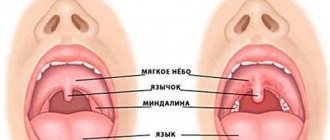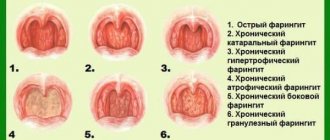Causes
Gonorrhea as a disease is one of the most common sexually transmitted infections. Although the classic form of this pathology is caused by the involvement, first of all, of the organs of the genitourinary system, there is a comprehensive classification of lesions localized outside its boundaries. At the same time, gonococcal inflammation can have both an acute and chronic course, and sexual transmission, although the most likely and common, is not the only possible route of infection.
Gonorrheal pharyngitis, or oropharyngeal gonorrhea, occurs when gonococcus enters the oropharynx. The source of infection is a patient with gonorrhea. In this case, the transfer of an infectious agent from the affected area (usually the genitals) to the contact mucosa is most often initiated. Inflammation of the pharynx develops as a result of unprotected oral-genital contact.
Other possible routes of infection:
- contact and household (use of shared towels, cutlery);
- perinatal (when the fetus comes into contact with the mucous membrane of the mother’s genital organs during childbirth);
- when kissing (if one of the partners suffers from a gonococcal infection of the pharynx).
Gonococcal pharyngitis can occur not only in adults, but also in children.
Cases of inflammation of the pharynx caused by gonococcus occur in different age categories of patients. If adults and children come into close contact at home and violate hygiene rules, the likelihood of infection increases. All contact persons have a risk of becoming infected, regardless of their age.
What type is this?
in the photo there is gonorrheal (gonococcal) pharyngitis
Gonococcal pharyngitis is very rare in medical practice. In most cases, patients faced with this disease are people leading an immoral lifestyle, who are not picky in their choice of sexual partners and do not care about using contraception during intimacy. The peculiarity of this form of inflammatory process in the throat is that the disease develops as a result of unprotected oral sex, in which one of the partners suffers from a sexually transmitted disease caused by a gonococcal infection.
Despite the fact that the pathogenic microorganism itself belongs to bacterial microflora, which is transmitted exclusively through sexual contact, microbes of this species still have a natural ability to adapt to a new environment.
At the same time, the period of adaptation to the epithelial tissues of the larynx and other organs located in the circle lasts very little time. Unlike other forms of pharyngitis, the gonococcal type of disease progresses very quickly and is characterized by the formation of purulent discharge, which, depending on the level of the patient’s immune system, can form in copious quantities. In 78% of cases, the inflammatory process involves not only the surface of the throat and lower parts of the pharynx, but also the tongue and even the gums located in the oral cavity. The extent of the infectious lesion significantly complicates the treatment process and increases the risk of the disease progressing to the chronic stage with periodic exacerbations.
Symptoms
For pharyngitis caused by the causative agent of gonorrhea, a rapid course is not typical. Although the onset of the disease may be sudden, the patient's condition cannot be considered severe. The first signs may appear several days after infection, so with timely treatment it is easier to establish the fact of direct or indirect contact with a patient with gonorrhea.
Patient complaints
- Dryness, irritation, scratching in the throat area.
- Moderate pain when swallowing and talking.
- Moderate hoarseness.
- General weakness, drowsiness, fatigue.
- Increased body temperature values.
Fever, as a rule, is within the subfebrile range (37.1-37.9 ° C), observed in the acute period and persists for several days. In this case, there is no pronounced intoxication syndrome, the general condition is slightly or moderately disturbed.
Gonococcal pharyngitis does not have any specific features and can be asymptomatic.
In some cases, patients do not complain, experiencing only minor discomfort in the throat. They may associate it with inhaling dry, dusty air, smoking, or not paying attention at all. An “empty” sip causes minor pain.
Objective signs
When examining the oropharynx, you can see the following changes in the mucous membrane:
- redness;
- swelling;
- grain;
- filmy overlays.
Both the pharynx and the palatine tonsils are affected - they enlarge, turn red, and become covered with a yellow-gray coating. On the back wall of the pharynx, reddened, enlarged follicles in the form of grains stand out.
Drug therapy
Gonorrhea of the throat is treated only according to a regimen drawn up by a doctor. To suppress it, antibiotics, drugs for external use, symptomatic drugs, and drugs to boost immunity are needed.
Antibiotic therapy
For the treatment of gonococcal pharyngitis, antibiotics belonging to the following groups are used:
- Cephalosporins - agents that damage the cell membranes of gonococci;
- Penicillins - drugs that disrupt the synthesis of cell walls of pathogens;
- Macrolides – drugs that inhibit the growth and reproduction of bacteria;
- Fluoroquinolones – medications that inhibit DNA gyrase or topoisomerase IV of microbes;
- Azalides are antibiotics that have anti-inflammatory and immunomodulatory effects.
Local and symptomatic remedies
Additional treatment for throat gonorrhea includes medications that reduce fever, painkillers, and immunostimulants.
Local treatment of the larynx is carried out using antiseptics. The oropharynx is irrigated with Miramistin and Chlorhexidine sprays.
Gargle with bactericidal solutions:
- Furacilin;
- Chlorophylliptom;
- Hydrogen peroxide.
After the exacerbation subsides and the temperature normalizes, inhalations are done with a salt solution, essential oils, herbs and other remedies applicable for common pharyngitis.
Diet therapy
If gonorrheal inflammation occurs in the oral cavity, it is necessary to adjust the diet. Patients are recommended:
- Eat soft, warm food. It reduces pain and makes swallowing easier.
- Prepare dishes that do not irritate the throat.
- Do not consume smoked foods, sweets, spicy, salty foods, alcohol.
- Maintain a drinking regimen: drink up to 2 liters of warm liquid daily.
Patients with throat gonorrhea need to drink plenty of fluids. Harmful bacteria and purulent discharge accumulate in their mouth. Drinking washes away pathogenic exudate from the mucous membranes, which speeds up recovery. For treatment prepare:
- berry fruit drinks;
- fruit water (lemon, orange, apple);
- compotes;
- herbal teas from chamomile, mint, sage, linden blossom;
- honey water.
Gonococci can change under the influence of antibiotics taken, which leads to dangerous complications. Antibiotic therapy should not be interrupted. An untreated gonorrheal infection becomes chronic. Symptoms of the pathology disappear, and bacteria destroy organs and systems.
After a course of treatment, it is necessary to take control tests. Based on their results, a person is judged to be healthy or needs re-treatment.
Infectious pharyngitis, that is, an inflammatory process in the pharynx, provoked by infectious agents, is extremely common. It can occur in isolation or be combined with damage to other anatomical parts of the respiratory system. At the same time, we cannot exclude the possibility that the causative agent of the infection is gonococcus, or Neisseria gonorrhoeae - a gram-negative bacterium that can infect the mucous membrane of not only the oropharynx, but also the genitals, conjunctiva, and rectum. To quickly establish a diagnosis and begin treatment, you need to know what symptoms accompany gonococcal pharyngitis.
The content of the article
Gonorrhea as a disease is one of the most common sexually transmitted infections. Although the classic form of this pathology is caused by the involvement, first of all, of the organs of the genitourinary system, there is a comprehensive classification of lesions localized outside its boundaries. At the same time, gonococcal inflammation can have both an acute and chronic course, and sexual transmission, although the most likely and common, is not the only possible route of infection.
Gonorrheal pharyngitis, or oropharyngeal gonorrhea, occurs when gonococcus enters the oropharynx. The source of infection is a patient with gonorrhea. In this case, the transfer of an infectious agent from the affected area (usually the genitals) to the contact mucosa is most often initiated. Inflammation of the pharynx develops as a result of unprotected oral-genital contact.
Other possible routes of infection:
- contact and household (use of shared towels, cutlery);
- perinatal (when the fetus comes into contact with the mucous membrane of the mother’s genital organs during childbirth);
- when kissing (if one of the partners suffers from a gonococcal infection of the pharynx).
Gonococcal pharyngitis can occur not only in adults, but also in children.
Cases of inflammation of the pharynx caused by gonococcus occur in different age categories of patients. If adults and children come into close contact at home and violate hygiene rules, the likelihood of infection increases. All contact persons have a risk of becoming infected, regardless of their age.
For pharyngitis caused by the causative agent of gonorrhea, a rapid course is not typical. Although the onset of the disease may be sudden, the patient's condition cannot be considered severe. The first signs may appear several days after infection, so with timely treatment it is easier to establish the fact of direct or indirect contact with a patient with gonorrhea.
Patient complaints
Dryness, irritation, scratching in the throat area.- Moderate pain when swallowing and talking.
- Moderate hoarseness.
- General weakness, drowsiness, fatigue.
- Increased body temperature values.
Fever, as a rule, is within the subfebrile range (37.1-37.9 ° C), observed in the acute period and persists for several days. In this case, there is no pronounced intoxication syndrome, the general condition is slightly or moderately disturbed.
Gonococcal pharyngitis does not have any specific features and can be asymptomatic.
In some cases, patients do not complain, experiencing only minor discomfort in the throat. They may associate it with inhaling dry, dusty air, smoking, or not paying attention at all. An “empty” sip causes minor pain.
Objective signs
When examining the oropharynx, you can see the following changes in the mucous membrane:
- redness;
- swelling;
- grain;
- filmy overlays.
Both the pharynx and the palatine tonsils are affected - they enlarge, turn red, and become covered with a yellow-gray coating. On the back wall of the pharynx, reddened, enlarged follicles in the form of grains stand out.
Pharyngitis in children
If a small child is infected, the disease proceeds as nasopharyngitis, involving the nasal mucosa in the pathological process. In addition, simultaneous inflammation of the eyes is also characteristic:
- redness and swelling of the eyelids;
- purulent discharge from the corners of the eyes;
- lacrimation, photophobia.
Objective changes in the pharyngeal mucosa coincide with the picture characteristic of adult patients. When establishing a diagnosis, anamnesis is important (the presence of gonococcal infection in the mother, the likelihood of domestic infection), since symptoms of eye damage do not occur in all patients, and the picture of changes in the oropharynx requires differentiating gonococcal pharyngitis from pharyngeal infections of other etiologies.
Causes of the disease and its diagnosis
Types of pharyngitis
Gonococcal pharyngitis, which is an inflammatory process of the mucous membrane and epithelium of the larynx, develops after infection of the body of an adult patient with the pathogenic microorganism gonococcus during sexual relations. Rapid progression of the disease leads to infection of the entire oral cavity. Gonococcal pharyngitis accompanied by gonorrhea of the throat resembles a purulent sore throat.
Diagnosis of the disease involves an initial examination by an otolaryngologist, collecting an anamnesis of the disease, identifying its clinical picture and undergoing special tests, based on the results of which the causative agent of the infection is determined. Laboratory testing involves identifying gonococci in smears taken from the throat and urogenital tract. The incubation period of the pathogenic microorganism, the causative agent of gonococcal pharyngitis and gonorrheal infection, ranges from one to thirty days. Timely identification of the source of infection allows you to begin effective treatment, avoiding the development of complications and irreparable consequences.
Treatment
When the diagnosis of pharyngitis of gonococcal etiology is confirmed, treatment necessarily includes:
The drugs of choice are antibiotics from the cephalosporin group (Ceftriaxone, Cefotaxime, Cefixime), fluoroquinolones (Ciprofloxacin), macrolides (Azithromycin). Therapy is carried out in a course, the dosage and frequency of taking the drugs is determined by the doctor based on the form of the course, age and body weight of the patient.
Local antiseptics (Miramistin, Chlorhexidine) are prescribed for irrigating the pharynx in the form of aerosols.
- diet (exclusion of spicy, salty foods, carbonated drinks, coffee);
- correction of microclimate parameters (air humidification, maintaining room temperature at 19-22 °C);
- quitting smoking and alcohol.
The basis of treatment for gonorrheal pharyngitis is to eliminate the causative agent of the infection.
Eradication, that is, the complete destruction of the infectious agent, is achieved through antibacterial therapy. It cannot be started independently, since the pathogen acquires resistance (resistance) if treated incorrectly. In addition, self-medication can lead to complications. Treatment of children is carried out as prescribed and under the supervision of a pediatrician.
After treatment, eradication control must be carried out - for this, microscopy of material (from the oropharynx cavity, other affected areas) and seeding of material on nutrient media can be used. Treatment is considered successful only in the absence of gonococci.
Pharyngitis of infectious origin can be caused by various pathogens , including infection with Neisseria gonorrhoeae (better known as gonococcus).
In this case, gonococcal or gonorrheal pharyngitis is diagnosed, and the disease can be localized not only in the larynx, but also affect other organs (eyes, respiratory tract, gastrointestinal tract).
Diagnostics
Is it possible to independently distinguish the gonococcal process from a common viral/bacterial infection of the pharynx? Definitely not, unfortunately, even a doctor without a special examination will not be able to determine the pathogen. To suspect gonococcal pharyngitis, the doctor must consider several factors:
Gonococcus - the causative agent of gonorrhea
- Patient with urogenital gonorrhea.
- Patient at risk.
- Patient with immunosuppressive status.
- Long-term, indolent inflammation of the pharynx/tonsils/larynx.
Despite all the apparent simplicity: one microbe - one disease - one treatment, gonorrhea is a rather serious disease that cannot always be immediately detected and quickly cured. Let us omit the features of diagnosing urogenital gonorrhea. You can identify gonococcus in the throat using the same methods as for genitourinary diseases:
- Smear.
- Sowing.
- PCR (polymerase chain reaction).
A smear from the pharyngeal mucosa followed by staining and microscopy (bacterioscopic method) is the simplest and most cost-effective method. Unfortunately, its information content leaves much to be desired. The fact is that gonococcus is a rather “cunning” microorganism. Upon initial contact with the mucous membrane, cellular immunity is activated. Macrophages enter the fight against the pathogenic agent. They absorb the bacterium, but cannot completely destroy it. This phenomenon is called incomplete phagocytosis. Such a gonococcus swallowed by a macrophage loses its ability to move, but is under reliable protection of the macrophage. Intracellular bacteria cannot be affected by antibiotics and cannot be detected in a smear.
Sowing from the mucous membrane of the nose and pharynx for microflora and sensitivity (bacteriological method) is more informative, but as practice shows, gonococci are sown in their pure form extremely rarely.
Polymerase chain reaction is the most informative and accurate method. PCR detects pathogen antigens, even if it is inside the cell. In addition, PCR can detect antibodies that the human body produces to fight the microbe. One of the significant disadvantages of PCR is the inability to determine the severity of the process: a person is sick now, or was sick many years ago. In case of a positive test (PCR), it is advisable to conduct another blood test from a vein - ELISA (immunofluorescence analysis) for antibodies to gonococci. Depending on which antibodies are elevated, acute or chronic gonococcal pharyngitis can be diagnosed.
Differential diagnosis
When trying to identify the cause of prolonged sore throat, pain and discomfort, we must not forget about atypical pathogens: chlamydia and mycoplasma. These microorganisms cause diseases of the genitourinary area and, like gonococcus, can cause diseases of the oral cavity and pharynx. Like the gonorrheal process, chlamydial pharyngitis has a mild, often asymptomatic course. This type of pharyngitis is characterized by an almost complete absence of changes in the mucous membrane of the oral cavity and pharynx. Only a very experienced doctor can suspect chlamydial pharyngitis based on specific swelling of the mucous membrane, excessive formation of discharge, and so on. As in the case of gonococcus, the only reliable way to detect chlamydia is PCR. Chlamydia cannot be detected in a smear; they do not reproduce in normal environments. Chlamydial pharyngitis is often detected in combination with other infections of the mouth and pharynx.
To treat gonorrheal pharyngitis, all the same drugs are used as for the treatment of ordinary sore throat, but with the obligatory prescription of antibiotics. In addition, during therapy you should:
- Eat and drink from separate containers.
- Avoid close contact (do not kiss, do not sleep in the same bed) with other healthy family members, especially children.
- Complete sexual rest, any type of sexual contact is prohibited.
- A gentle diet without alcohol, spicy, sweet, salty foods.
Of the antibacterial drugs, cephalosporins (Ceftriaxone, Cefotaxime), protected penicillins (Amoxiclav, Flemoclav), macrolides (Clarithromycin, Josamycin), fluoroquinolones (Levofloxacin, Moxifloxacin) are most often prescribed. The choice of antibiotic depends on the patient's condition and drug history. Treatment for gonorrheal pharyngitis must be taken by both spouses (sexual partners). Other usual methods of treatment: rinsing, inhalation, remedies for sore throat can also be used, it will not get worse.
Gonococcal or gonorrheal pharyngitis
Inflammation of the mucous membrane of the larynx as a result of the activity of gonococci is called gonorrheal pharyngitis.
Often this pathology does not occur in isolation, but develops in parallel with lesions of the urogenital tract.
Moreover, in the case of damage to the tissues of the throat, it is extremely rare that the disease occurs in a localized manner: most often it spreads to the tonsils, palatine arches, uvula, as well as to the oral cavity, spreading to the gums and tongue.
This pathology can be practically asymptomatic , which significantly complicates diagnosis.
This form of pharyngitis, if left untreated, is characterized by a transition to a chronic form (if the symptoms of the disease do not disappear for two or more months).
Treatment of pathology
To effectively solve the problem of gonococcal pharyngitis, caused by infection of the body of an adult with a pathogenic microorganism, complex treatment is prescribed. Patients must strictly follow the recommendations of the otolaryngologist. Drug therapy involves taking a number of medications. Their liver contains:
- antibacterial drugs that have a direct effect on the infectious agent: Amoxicillin, Azithromycin, Ceftriaxone, Levofloxacin;
- immunomodulating drugs, the action of which is aimed at increasing the protective functions of the body;
- antiseptics that eliminate pathogenic microflora from the mucous membrane of the larynx;
- medications with antiallergic properties, eliminating severe swelling of the nasopharynx;
- pharmaceutical products, the use of which helps strengthen the vascular system.
Symptoms of the disease
Unlike other types of pharyngitis, the gonorrheal form is not so violent and develops gradually , and regardless of the severity of the disease, the patient feels relatively well and stable.
The incubation period in this case is 1-3 days, after which the development of several or all of the following symptoms is noted:
- irritation and dryness of the larynx;
- general fatigue , drowsiness and weakness;
- body temperature to approximately 38 degrees and persists for several days;
- When swallowing and talking, there is a moderate pain syndrome in the throat ;
- the voice sits down and becomes hoarse;
- the soft tissues of the larynx and the mucous membrane of the throat swell and turn red;
- Bright red follicles sometimes appear on the back wall of the larynx and tonsils ;
- bleeding from the gums is possible , which soften, and signs of gingivitis may be observed;
- an unpleasant specific odor appears in the patient’s mouth , which cannot be eliminated by any hygiene means;
- the surface of the larynx is covered uneven coating of gray-yellow color ;
- dry persistent cough;
- violation of swallowing functions ( dysphagia );
- enlargement of the submandibular and cervical lymph nodes , upon palpation of which painful sensations occur.
Moreover, the causes of such a disorder in humans are usually not associated with a throat disease.
He believes that this is the result of smoking abuse or a consequence of prolonged exposure to a polluted or dusty environment.
It is worth noting that in such cases, the alarming symptoms last no more than a day , and if the discomfort in the throat does not go away within two to three days, it makes sense to be examined for the presence of gonococcal pharyngitis.
What are the typical symptoms?
Unlike other forms of inflammatory diseases of the larynx, gonorrheal pharyngitis develops gradually, and the patient does not feel discomfort or symptoms of the disease as a result of exposure to infection for a long time. On average, the incubation period lasts from 1 to 3 days, after which the first symptoms appear. The list of main symptoms of the disease due to infection includes:
- dry mouth and irritation of the larynx;
- weakness, increased fatigue, constant desire to sleep;
- increase in body temperature to 38 ⁰C, which remains stable for several days;
- pain when swallowing;
- swelling of the larynx, redness of its tissues;
- the appearance of a yellow-gray coating on the mucous membrane, the appearance of an unpleasant odor from the mouth that cannot be eliminated;
- dry lingering cough;
- an increase in the size of the lymph nodes, which respond with pain when pressed.
The above symptoms of infection may appear with gonococcal pharyngitis, but more often the patient complains of pain in the larynx. A person often mistakenly attributes such discomfort not to illness, but to smoking or prolonged exposure to a polluted environment. The cause of the disease is revealed only as a result of bacteriological examination.
Methods of treating the disease
local complex treatment is generally , during which it is necessary to treat the affected areas of the pharynx.
It is performed by irrigating the larynx with local antiseptics chlorhexidine and miramistin in the form of aerosols.
- 3% hydrogen peroxide;
- Orasept (a ready-made solution for rinsing, which is sold in pharmacies without a doctor’s prescription);
- “sea water” (one spoon of salt and baking soda per glass of water);
- Furacilin (sold in the form of a solution or tablets that must be crushed and dissolved in water);
- Chlorophyllipt (a natural-based solution that can even be used to treat children);
- Herbal decoctions (sage, rose hips, oak bark, chamomile).
For effective treatment, rinsing must be done at least three times a day , two hours before meals, and eating after the procedure is possible no earlier than an hour later.
If you start rinsing in the first days of disease development, there is a high probability that drug treatment will not be needed.
In such a short period, pathogenic microorganisms will not have time to settle on the surface of the mucosa.
Therefore, in such small quantities, you can simply “rinse” them.
The entire course of treatment must be monitored by the attending physician , making appropriate adjustments if necessary.
Upon completion of treatment, the patient must undergo a control swab from the throat in order to find out whether there are any small infectious foci remaining.
Prevention of gonorrheal pharyngitis
Gonorrheal pharyngitis and gonorrhea affecting the genitourinary tract have many similar signs and symptoms, and preventive measures in both cases are also not much different.
In particular, for these two diseases, the following prevention recommendations must be followed:
- It is important to avoid sexual intercourse during treatment of the disease , and if this is not possible, condoms must be used.
- After sexual (especially oral) contact, it is necessary to thoroughly treat the genitals with an antiseptic solution (Miramistin is best suited for this) and take a shower using antibacterial soap.
- You should regularly rinse your mouth with a solution of hydrogen peroxide (just add a few drops of this product to a glass of water).
- In some cases, the infection can also be transmitted through household contact, so it is always necessary to adhere to general rules of personal hygiene . You need to wash your hands with soap after going outside or traveling on public transport, use only a personal towel and hygiene products, and, if possible, use disposable tableware in public catering areas.
Causes and routes of infection
Gonorrhea is rightfully considered a very common infectious disease that is sexually transmitted. The standard type of this disease involves damage to the genitourinary system. But there is an extensive classification of localization beyond these areas. The inflammatory process caused by gonococci can be chronic or acute. It is possible to become infected not only through sexual contact, although this is the most common route of transmission.
Gonococcal pharyngitis - appears if gonococcus enters the oral cavity. The carrier of the infection is a person suffering from gonorrhea. Often the infection is transferred from the affected organ (genital tract) to the mucous membrane.
The inflammatory process is formed in the absence of the use of protective equipment during oral-genital sexual contact.
Additional routes of infection:
- Transmission of the infection occurs through a kiss, when one partner suffers from gonococcus located in the oropharynx;
- Household contact. This implies the use of shared utensils and towels;
- When the fetus touches the mother's genital mucosa during childbirth (perinatal contact).
A disease of this nature can appear in both adults and children. All age categories of people are exposed to infection. Failure to comply with personal hygiene rules increases the risk of transmission of the disease from an adult to a child.
Diagnostics
It is impossible to distinguish gonococcal pharyngitis from other throat diseases on your own. Only a doctor makes a diagnosis; he identifies the disease based on test results. If you suspect gonorrhea of the throat, do the following:
- take a smear;
- do sowing;
- carry out PRC (polymerase chain reaction).
The smear sometimes gives false results. When the pathogen enters the mucous membranes in the patient’s body, cellular immunity is activated. Macrophages begin to fight bacteria. They, having absorbed microbes, try to digest them. But they fail to completely destroy gonococci.
If phagocytosis is not completed, the bacteria do not die, they only lose the ability to move. Macrophages, immobilizing gonococci, provide them with protection. The bacteria are not affected by the antibiotic; they are not detected in the smear.
The bacteriological method gives more accurate results. But when inoculating from mucous membranes, a pure pathogen is sown occasionally.
Using the polymerase chain reaction, it is possible to detect even protected bacteria (located inside the cell). This method also allows you to detect antibodies produced to the gonorrhea agent.
Differential diagnosis
Pharyngitis is caused not only by gonococci. Other pathogens also lead to it. The disease is caused by chlamydia, agents that infect the genitourinary system and oropharynx.
Chlamydial pharyngitis flows secretly, without showing symptoms, or gives mild symptoms. Only a doctor can distinguish gonococcal pharyngitis from other types of pathology. He notes what the mucous membranes in the oropharynx look like, specific signs of diseases, and confirms suspicions with the results of the tests obtained.
Symptoms
Gonococcal pharyngitis, which is provoked by gonorrhea, proceeds calmly in most cases. The appearance of the disease may be unexpected, but the patient’s well-being does not cause panic. Initial signs are observed a couple of days after infection.
Let's consider what the patient complains about:
- the throat feels dry and sore;
- pain when swallowing and during conversation;
- hoarseness of voice;
- state of weakness;
- temperature increase.
The acute form of the disease is often accompanied by fever and lasts for several days. There is no intoxication, the general condition is slightly worsening.
Gonococcal pharyngitis is often asymptomatic. Patients do not complain about anything, they only feel discomfort in the throat. The patient does not pay attention to minor pain in the throat and sees the cause of the disease in dry air or abuse of bad habits.
In adults
Upon examination, the doctor notices changes on the surface of the mucous membrane: a scarlet tint; edema; filmy overlays; grain; inflammation of the gums and tongue. In addition to the pharynx, the tonsils are also affected - they increase in volume, a yellow-gray coating and redness are noticeable on their surface. The back wall of the throat is characterized by the presence of enlarged follicles that look like grains.
In children
If a baby is infected, the disease is similar to nasopharyngitis with involvement of the nasal mucosa in the inflammatory process. In addition, there is an inflammatory process in the eyes: tears flow, it hurts to look at the light; eyelids swell and turn red; There is noticeable pus at the corners of the eyes.
A modification occurring in the throat, such as in an adult. When making a diagnosis, it is important to find out whether the mother had a gonococcal infection, because signs of damage to the eye area are not observed in all patients; the clinical picture in the oral cavity calls for correlating gonococcal pharyngitis with throat infections of other origins.
Causes and symptomatic manifestations
The main cause of gonococcal pharyngitis is the same pathogen that causes a disease such as gonorrhea - gonococcus. This disease belongs to a number of sexually transmitted diseases.
Gonorrheal pharyngitis is a specific disease that can occur either alone or in combination with urogenital gonorrhea. In this case, the disease affects not only the throat, but also the palate, nasal cavity, tonsils and larynx. Most often, the disease is completely asymptomatic, with the exception of signs characteristic of ordinary pharyngitis. You may experience symptoms such as:
pain in the throat;- constant dryness;
- soreness;
- dry cough.
The only difference between gonorrhea and pharyngitis is that with gonococcal pharyngitis, signs of the disease can be observed for a long time, and they can also return periodically, regardless of whether the patient has undergone treatment or not. In the photo you can see that visually gonococcal pharyngitis is no different from ordinary pharyngitis.
Diagnostics and research methods necessary tests
It is not possible to diagnose gonorrheal pharyngitis and distinguish it from other diseases on your own. You cannot do without the consultation and help of a doctor, who will prescribe tests to confirm the diagnosis. If you suspect gonorrhea, you must take a throat swab; carry out PCR; do the sowing.
The smear does not always give the correct results. When the pathogen penetrates the mucous membrane of the patient, the human body activates immunity at the cellular level. Macrophages begin to fight bacteria. Having absorbed microorganisms, they attempt to digest them. But, unfortunately, gonococci cannot be destroyed.
If the destruction process is not completed, then the bacteria do not die, but are deprived of the ability to move. The antibiotic does not affect bacteria; they do not show up in the smear.
It is possible to obtain more accurate results using the bacteriological method. The pathogen is only occasionally isolated from the surface of the mucous membranes.
The causative agent of pharyngitis is not only gonococcus. This disease is also caused by other pathogens, such as chlamydia, which infect the genitourinary area, but also cover the oral cavity.
Pharyngitis caused by chlamydia is often asymptomatic and has invisible symptoms. Only a doctor can determine this form of the disease. He examines the oral cavity, takes into account the symptoms of the disease and, based on the results obtained, draws conclusions and prescribes treatment.
Gonococcal pharyngitis - diagnosis
It is impossible to distinguish gonococcal pharyngitis from other throat diseases on your own. Only a doctor makes a diagnosis; he identifies the disease based on test results. If you suspect gonorrhea of the throat, do the following:
- take a smear;
- do sowing;
- carry out PRC (polymerase chain reaction).
The smear sometimes gives false results. When the pathogen enters the mucous membranes in the patient’s body, cellular immunity is activated. Macrophages begin to fight bacteria. They, having absorbed microbes, try to digest them. But they fail to completely destroy gonococci.
Prevention
Gonorrheal pharyngitis and gonorrhea, which affects the genitourinary system, have many of the same symptoms; the prevention of these diseases is almost the same.
Practical tips:
- During the treatment period, it is necessary to abstain from sexual intercourse, if this is not possible, use protective equipment (condoms);
- Miramistin (antiseptic solution) is used after sexual and oral contact, treating the genitals well. Afterwards, take a shower with antibacterial soap;
- Rinsing the mouth with a solution of hydrogen peroxide is systematically recommended. For 250 ml. a couple of drops of this product;
- Maintain personal hygiene (infection can also be transmitted through household contact);
- Frequent hand washing and a personal towel are provided; in canteens and cafes it is better to eat from disposable tableware.











